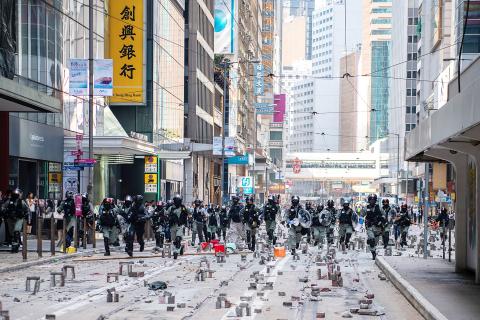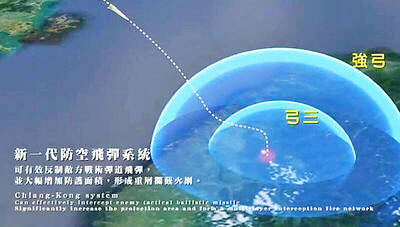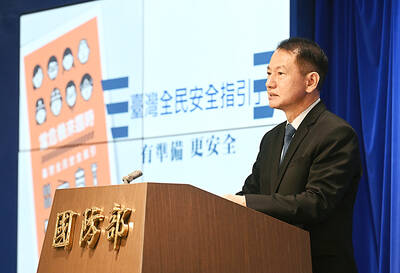Pro-democracy protesters yesterday stepped up a “blossom everywhere” campaign of road blocks and vandalism across Hong Kong that has crippled the territory this week and ignited some of the worst violence in five months of unrest.
The new phase in the crisis, which has forced schools and shopping malls to close, as well as the shutdown of large chunks of the vital train network, has prompted police to warn that the territory is on the verge of “total collapse” and a “breakdown.”
China, facing the biggest challenge to its rule of the territory since it was handed back by Britain in 1997, has insisted it will not buckle to the pressure and warned of even tougher security measures.

Photo: Bloomberg
As they have since the start of the week, protesters yesterday choked roads and blocked traffic with anything they could lay their hands on, including bricks, bicycles, couches and other items.
Key arterial routes were targeted in morning and after-work peak hours.
Various lines on the subway — used daily by more than half of the territory’s 7.5 million people — were also suspended, forcing many workers to stay at home.
In the Central business district, hundreds of people left their offices at lunchtime to join the more hardcore protesters setting up barricades outside luxury-item shops and the headquarters of large financial firms.
Masked protesters dressed in their signature black were also locked in a series of tense standoffs at university campuses, following intense clashes on Tuesday night that saw police fire tear gas and rubber bullets.
Highlighting the growing security fears, Chinese students began fleeing Hong Kong on buses and boats back across the border, police and universities said, although it was not immediately clear how many had left.
The chaos was part of the largely leaderless protest movement’s new strategy branded “blossom everywhere,” in which small groups target as many parts of the territory as possible to cause maximum disruption and stretch police resources.
Until this week, protesters had largely confined their actions to evenings and the weekends.
The campaign began on Monday with an effort to shut down trains and enforce a territory-wide strike, and has for the first time seen three straight days of chaos during the working week.
“The rioters’ intention is to bring Hong Kong into a total breakdown. No excuse, no political motives can justify or glory this madness,” police spokesman John Tse (謝振中) told reporters yesterday.
A day earlier, one of his colleagues said Hong Kong was “on the brink of total collapse.”
The poisonous atmosphere worsened on Monday morning when a police officer shot an unarmed 21-year-old protester, leaving him in critical condition.
It was the third confirmed instance police had hit someone with live rounds since the unrest began.
The shooting, broadcast live on Facebook, exacerbated fury among protesters about what they say is excessive police violence.
However, fears have also risen about increasingly violent tactics from the protesters.
On Monday, a 57-year-old man, who had been arguing with protesters, was doused with a flammable liquid and set on fire. He was hospitalized in critical condition.
The protest movement has been fueled by anger that China is choking the liberties and freedoms that Hong Kong is meant to have under the terms of the handover deal with Britain.
Instead of offering concessions, China has responded with ominous warnings that it is prepared to further curb freedoms and that it wants tougher security measures.
On Tuesday, the People’s Daily said that local elections due to be held on Nov. 24 could be canceled if the protesters do not back down.
“Only by supporting the police force to decisively put down the riots can [Hong Kong] return to peace and hold fair elections, to help Hong Kong start again,” the newspaper said.
Still, China is not yet prepared to take such drastic action as military intervention as it plays a longer game of weakening and intimidating the protest movement, said Ben Bland, Sydney-based director of the Southeast Asia Project at the Lowy Institute.
“It still seems, as far as we can tell, that the most likely response is going to continue to be led by the Hong Kong authorities and the Hong Kong police,” Bland said.

LIMITS: While China increases military pressure on Taiwan and expands its use of cognitive warfare, it is unwilling to target tech supply chains, the report said US and Taiwan military officials have warned that the Chinese People’s Liberation Army (PLA) could implement a blockade within “a matter of hours” and need only “minimal conversion time” prior to an attack on Taiwan, a report released on Tuesday by the US Senate’s China Economic and Security Review Commission said. “While there is no indication that China is planning an imminent attack, the United States and its allies and partners can no longer assume that a Taiwan contingency is a distant possibility for which they would have ample time to prepare,” it said. The commission made the comments in its annual

DETERMINATION: Beijing’s actions toward Tokyo have drawn international attention, but would likely bolster regional coordination and defense networks, the report said Japanese Prime Minister Sanae Takaichi’s administration is likely to prioritize security reforms and deterrence in the face of recent “hybrid” threats from China, the National Security Bureau (NSB) said. The bureau made the assessment in a written report to the Legislative Yuan ahead of an oral report and questions-and-answers session at the legislature’s Foreign Affairs and National Defense Committee tomorrow. The key points of Japan’s security reforms would be to reinforce security cooperation with the US, including enhancing defense deployment in the first island chain, pushing forward the integrated command and operations of the Japan Self-Defense Forces and US Forces Japan, as

INTERCEPTION: The 30km test ceiling shows that the CSIST is capable of producing missiles that could stop inbound missiles as they re-enter the atmosphere Recent missile tests by the Chungshan Institute of Science and Technology (CSIST) show that Taiwan’s missiles are capable of intercepting ballistic missiles as they re-enter the atmosphere and pose a significant deterrent to Chinese missile threats, former Hsiung Feng III missile development project chief engineer Chang Cheng (張誠) said yesterday. The military-affiliated institute has been conducting missile tests, believed to be related to Project Chiang Kung (強弓) at Pingtung County’s Jiupeng Military Base, with many tests deviating from past practices of setting restriction zones at “unlimited” and instead clearly stating a 30.48km range, Chang said. “Unlimited” restrictions zones for missile tests is

PUBLIC SAFETY: The nationwide distribution campaign aims to enhance society’s overall understanding of threats and bolster defense awareness, an official said The latest edition of the National Public Safety Guide is being mailed to all citizens starting today to foster public awareness of self-defense in the event of war or natural disasters, the Ministry of National Defense said yesterday. “The guides will be disseminated to the public to enhance society’s overall understanding of threats and bolster defense awareness, demonstrating the government’s emphasis on people’s safety and its determination to pursue self-defense,” All-out Defense Mobilization Agency Director Shen Wei-chih (沈威志) said at the ministry’s news conference. The nationwide distribution campaign was planned according to President Lai William’s (賴清德) Sept. 20 directive, he said, adding